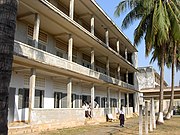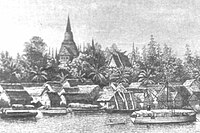Phnom Penh (Khmer: ភ្នំពេញ, official Romanization: Phnum Pénh; pronounced [pʰnum pɯɲ] in Khmer and /pəˈnɒm ˈpɛn/ or /ˈnɒm ˈpɛn/ in English) is the capital and largest city of Cambodia. It is also the capital of the Phnom Penh municipality. It is an economic, industrial, commercial, cultural, tourist and historical center in the country.
Once known as the "Pearl of Asia" in the 1920s, Phnom Penh, along with Siem Reap, is a significant global and domestic tourist destination for Cambodia. Phnom Penh is known for its traditional Khmer and French influenced architecture.
Phnom Penh is the wealthiest and most populous city in Cambodia. It is also the commercial, political and cultural hub of Cambodia and is home to more than 2 million of Cambodia's population of over 14 millionEtymology
Phnom Penh City takes its name from the present Wat Phnom or Hill Temple. Legend has it that in 1372, an old nun named Penh went to fetch the water in the Mekong river and found a dead Koki tree floating down the stream. Inside the hole of that dead Koki tree contained four bronze and one stone Buddha statues in it.
Daun (Grandma) Penh brought the statues ashore and ordered people to pile up earth at northeast of her house and used those Koki trunks to build a temple on that hill to house the five Buddha statues, then named the temple after her as Wat Phnom Daun Penh, which presently known as Wat Phnom, a small hill of 27 metres (89 ft) in height.
Phnom Penh was also previously known as Krong Chaktomuk (Khmer: ក្រុងចតុមុខ) meaning "City of Four Faces". This name refers to the junction where the Mekong, Bassac, and Tonle Sap rivers cross to form an "X" where the capital is situated. Krong Chaktomuk is an abbreviation of its ceremonial name given by King Ponhea Yat which full named Known as "Krong Chaktomuk Mongkol Sakal Kampuchea Thipadei Sereythor Inthabot Borei Roth Reach Seima Maha Nokor" (Khmer: ក្រុងចតុម្មុខមង្គលសកលកម្ពុជាធិបតី សិរីធរបវរឥន្ទបត្តាមុនី រដ្ឋរាជសីមា មហានគរ). This ceremonial name is composed into Pali, translates clearly but not official right as " The Place of Four river that give a happiness and success of Kampuja Kingdom, the highest leader as well as impregnable city of God Indra of the enormous Kingdom".History
Phnom Penh first became the capital of Cambodia after Ponhea Yat, king of the Khmer Empire, moved the capital from Angkor Thom after it was captured by Siam a few years earlier. There are stupa behind Wat Phnom that house the remains of Ponhea Yat and the royal family as well as the remaining Buddhist statues from the Angkorean era. There is a legend that tells how Phnom Penh was created. In the 1600s, Japanese immigrants settled on the outskirts of Phnom Penh. [6]
Phnom Penh remained the royal capital for 73 years from 1432 to 1505 when it was abandoned for 360 years from 1505 to 1865 by subsequent kings due to internal fighting between the royal pretenders. Later kings moved the capital several times and established their royal capitals at various locations in Tuol Basan (Srey Santhor), Pursat, Longvek, Lavear Em and Oudong.
It was not until 1866, under the reign of King Norodom I, that Phnom Penh became the permanent seat of government, and the current Royal Palace was built. Beginning in 1870, the French Colonialists had turned a a riverside village into a city when it started to build hotels, schools, prisons, barracks, bank, public works offices, telegraph offices, Law courts, and health services buildings. In 1872, the first glimpse of a modern city took shape when the colonial administration contracted a French contractor, Le Faucheur, to construct the first 300 concrete houses for sales and rentals to the Chinese traders.
By the 1920s, Phnom Penh was known as the Pearl of Asia, and over the next four decades continued to experience growth with the building of a railway to Sihanoukville and the Pochentong International Airport (now Phnom Penh International Airport).Phnom Penh under the period of Sihanouk’s rule had seen the expansion and the constructions of many modern infrastructures.The city had been expanded and many infrastructures had been built.[7])

During the Vietnam War, Cambodia was used as a base by the North Vietnamese Army and the Viet Cong, and thousands of refugees from across the country flooded the city to escape the fighting between their own government troops, the NVA/NLF, the South Vietnamese and its allies and the Khmer Rouge. By 1975, the population was 2,000,000, the bulk of them refugees from the fighting. The city fell to the Khmer Rouge on April 17. Many of its residents, those who were wealthy and educated, were forced to do labor on rural farms as "new people". Tuol Svay Prey High School was taken over by Pol Pot's forces and was turned into the S-21 prison camp, where Cambodians were detained and tortured. Pol Pot sought a return to an agrarian economy and therefore killed many people perceived as educated, "lazy" or political enemies. Many others starved to death as a result of failure of the agrarian society and the sale of Cambodia's rice to China in exchange for bullets and weaponry. The former high school is now the Tuol Sleng Genocide Museum where Khmer Rouge torture devices and photos of their victims are displayed. Choeung Ek (The Killing Fields), 15 kilometres (9 mi) away, where the Khmer Rouge marched prisoners from Tuol Sleng to be murdered and buried in shallow pits, is also now a memorial to those who were killed by the regime.
The Khmer Rouge were driven out of Phnom Penh by the Vietnamese in 1979[8] and people began to return to the city. Vietnam is historically a state with which Cambodia has had many conflicts, therefore this liberation was and is viewed with mixed emotions by the Cambodians. A period of reconstruction began, spurred by continuing stability of government, attracting new foreign investment and aid by countries including France, Australia, and Japan. Loans were made from the Asian Development Bank and the World Bank to reinstate a clean water supply, roads and other infrastructure. The 1998 Census put Phnom Penh's population at 862,000;[9] by the next census in 2008 it was 1.3 million.


No comments:
Post a Comment